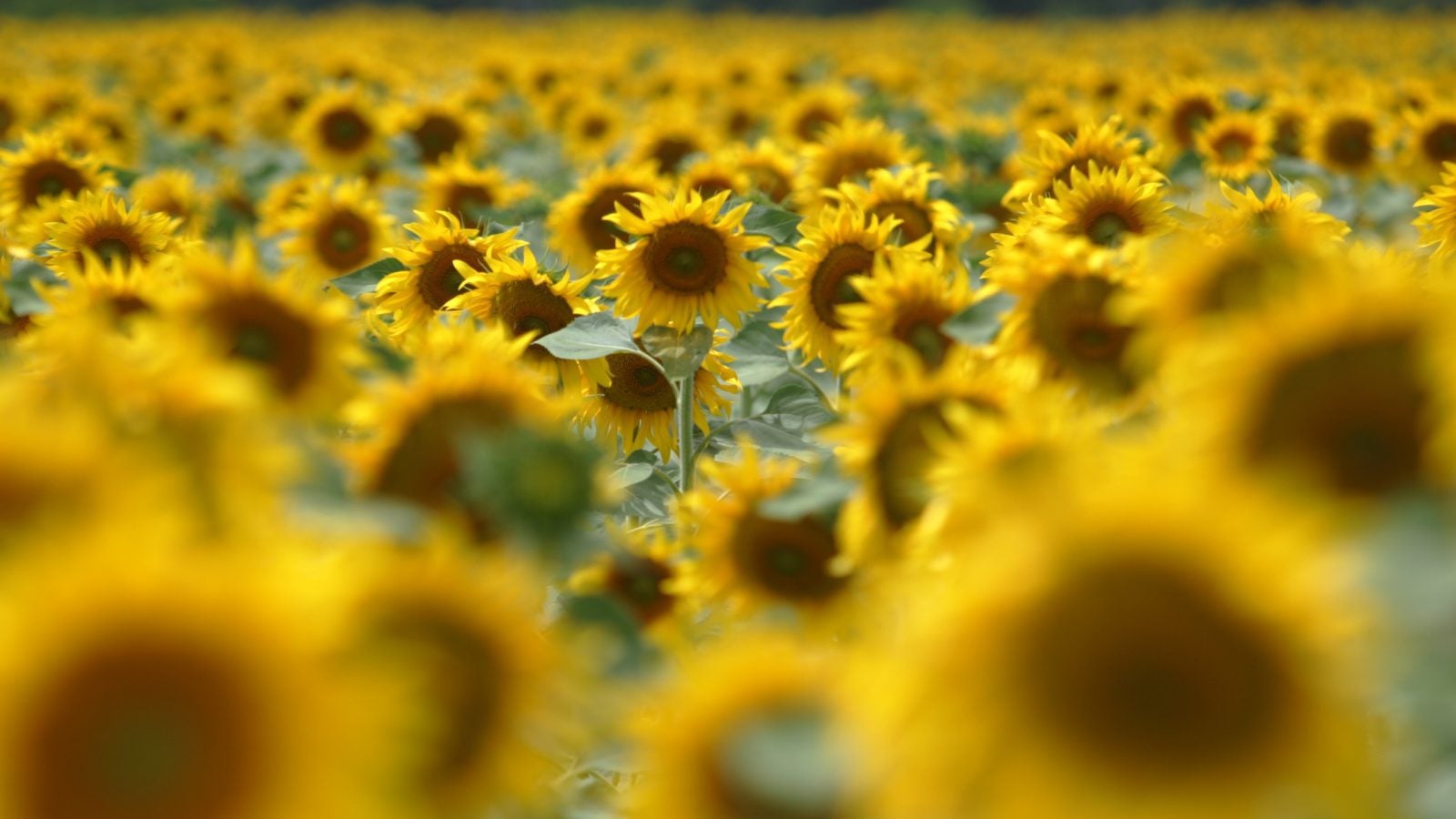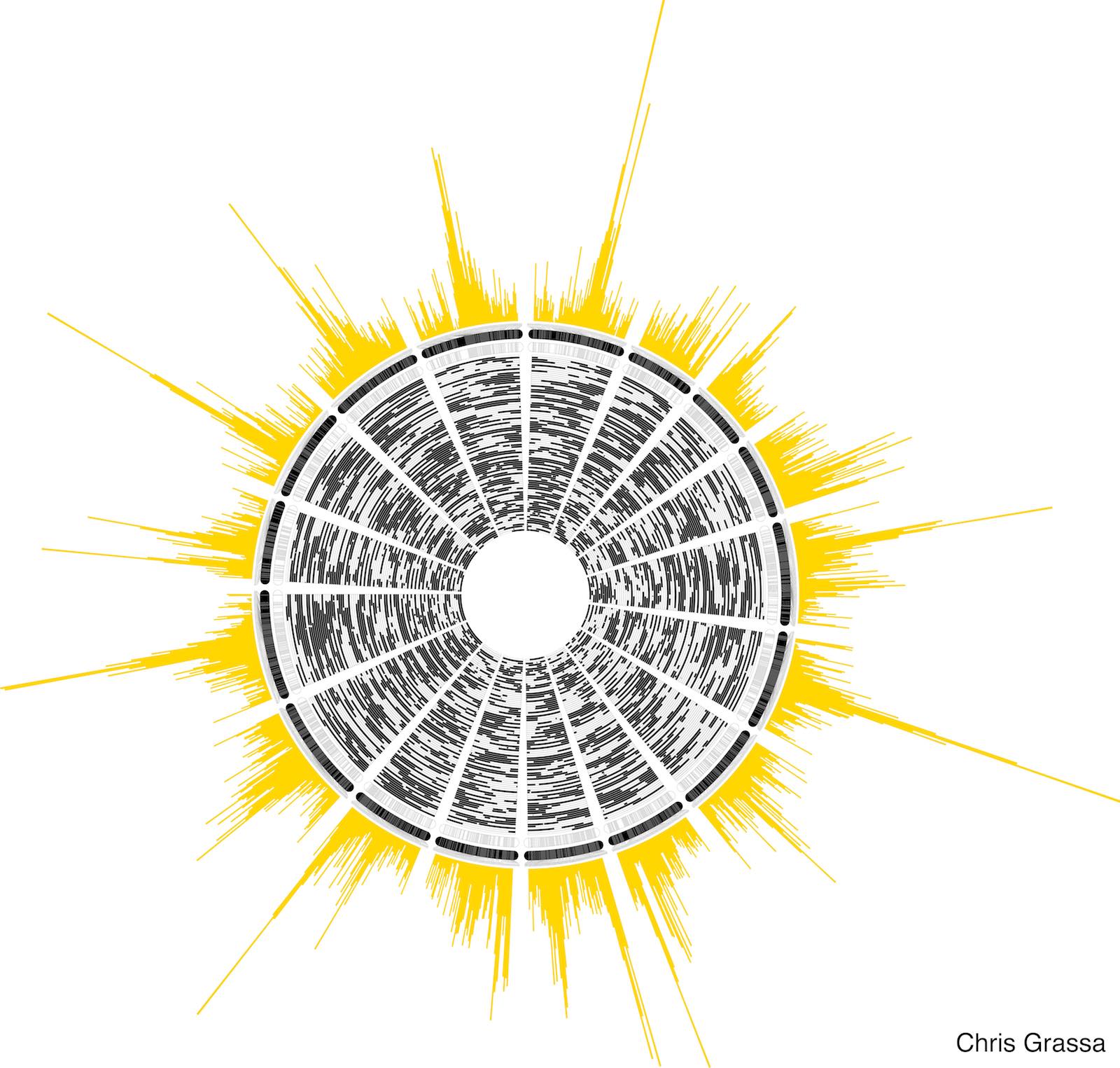One plant has the ability to help us understand climate change
The humble sunflower appears not quite of this earth. Its yellow crowned head sits atop its stalk like a green broomstick. Its seeds, arranged in a logarithmic spiral, are produced by tiny flowers called disc florets that emerge from the center of its head and radiate outward. But aside from being a biological marvel, the sunflower is also often in the scientific spotlight.


The humble sunflower appears not quite of this earth. Its yellow crowned head sits atop its stalk like a green broomstick. Its seeds, arranged in a logarithmic spiral, are produced by tiny flowers called disc florets that emerge from the center of its head and radiate outward. But aside from being a biological marvel, the sunflower is also often in the scientific spotlight.
From understanding how new plant species emerge to studying “solar tracking,” which is how the flowers align themselves with the sun’s position in the sky, sunflowers are a darling in the field of science. However, researchers can only get so far in understanding a plant without detailed genetic knowledge. And after close to a decade, it has finally unfurled itself.
An international consortium of 59 researchers who set their sights on the laborious task of sequencing and assembling the sunflower’s genome published their results in a 2017 study in Nature. This achievement will provide a genetic basis for understanding how the sunflower responds and adapts to different environments. “We are on the cusp of understanding sunflower adaptability,” says Loren Rieseberg, a leading sunflower expert at the University of British Columbia and a supervisor of this study.
With its genome assembled, scientists are hopeful for the next phase of the sunflower’s scientific career: as a “model crop” for studying climate adaptability in plants. This task is more complex and urgent now than ever. Climate change, according to a paper in the Annals of Botany, “will influence all aspects of plant biology over the coming decades,” posing a threat to crops and wild plants alike.
Part of what makes the sunflower useful for studying climate change is the plant’s natural resilience. Already well-equipped to withstand drought, high salinity, vastly variable ecosystems, and requiring little fertilizer, the sunflower is one of nature’s finest apocalypse preppers.
Admiring scientists are now hoping to maximize these capacities. Despite the sunflower’s queenly front, it can make a home out of anything, such as salt marshes, sand dunes, and the dry desert floor. “I’ve done work in the middle of the desert in these sand dunes, and there’re no plants around other than the sunflowers just hanging on,” says Christopher Grassa, a sunflower researcher at Harvard who was involved in this study.
Owing to its diversity and immense adaptability, sunflowers can be found in a range of ecosystems across North America, from the deserts of New Mexico to the cold plains of North Dakota. “As far as it comes to understanding climate change, a lot of these characteristics that we are really worried about, there are sunflower species that have already adapted to these extreme conditions,” says Michael Kantar, a University of Hawai’i at Manoa professor who runs Kantar’s Laboratory on the intersection between genomics, agriculture, and ecology. “So you have this incredible diversity that is there to mine. And now, from the genome, you can do that with much more precision,” Kantar says.
There are around 50 species of sunflower. Some have multiple, smaller flower heads (technically named inflorescences), some appear more bushy, some closer to the ground. The silver-leaf sunflower (Helianthus argophyllus), found on the coasts of Texas, is dusted in fine, silver hairs; the sunchoke (Helianthus tuberosus) has knobby, edible roots; and the winter’s sunflower (Helianthus winteri), found mainly along steep Californian cliffs, has a woody stem.
Another aspect of the sunflower’s appeal is what Kantar calls its “broad cultural acceptability”: The sunflower is known not just for its beauty, but as a food. It is one of the five largest oilseed crops in the world, and it is also used in baking, snacks, and birdseed. The first cultivators of the sunflowers were Native American nations—it is one of the few crops native to the US—and it is today widely cultivated around the world in Russia, Ukraine, China, Africa, Argentina, Europe, and its home turf in the United States.
The sunflower’s genome
The newly assembled sunflower genome gives scientists the ability to locate where genes are situated on the plant’s 17 chromosomes. This then allows researchers to hone in on more specific traits, from drought tolerance to “lodging,” which is the technical name for when sunflowers tip over in the wind. Rieseberg anticipates that future domestic sunflowers, cultivated to resist climate change, could have gray-green leaves with silvery, protective hairs to make them more drought-tolerant like the wild silver-leaf sunflower, as well as seeds that can hold even more oil. They may have stronger roots and stalks that do not fall to an assailing wind. They may even be “day neutral,” which means they’d open their flower without any cues from the sun.
Along with its practical uses, the assembled genome is an achievement in its own right. Grassa explains that the sunflower consists of long, repetitive strands, which makes it particularly vexing to sequence and assemble. If outstretched, the sunflower genome is 1.5 meters long and contains 3.6 billion base pairs—which is about double the number of genes as the human genome.
Before this study, scientists had a patchy knowledge of the sunflower’s genetic makeup. “We had just a very few landmarks on the genome that we knew,” says Brent Hulke, a sunflower researcher at the US Department of Agriculture. Hulke likens the former sketch of the genome to an old, outdated globe with misshaped continents. Now there is a much more precise map (the Google Maps of sunflowers, if you will) that scientists can use to cross-reference individual sunflowers’ genomes with the reference genome. The places where the two diverge provide insight into the genes that give rise to a particular variety or trait.
Camille Parmesan, one of the first people to document the impacts of climate change on wildlife in her 1996 paper on the Edith’s checkerspot butterfly, has “always felt that the sunflower system would be very nice to look at from a climate-change angle.” Like the Edith’s checkerspot butterfly, the sunflower’s broad distribution across North America allow scientists to study it in a range of climate conditions and understand the plant’s genetic limits. Plants everywhere are responding to climate change—a common response adjusting the flowering time—but the sunflower’s distribution lends itself to more granular study.

However, Parmesan does not like the term “model system,” which is an organism studied to understand a particular biological phenomenen. To her, it implies a system adapted for a lab. “I think sunflowers are actually better than [model systems] because you have a lot of ability to look at these differences in the field—both in crop fields, but also in wild systems.”
The interaction of a plant (or any organism) and its environment is as vitally important as it is complex. A species’ ability to both evolve across generations and alter its growth in response to the environment (known as plasticity) are critical to if it will survive in an uncertain, variable climate, though it’s often hard to differentiate these responses. Plants within the most historically stressful, variable climates, such as Texas, will likely survive the best, though this is still a nascent area of research. “It’s those species that are from climates that are already stressed that seem to do better than species from climates that are more benign,” Parmesan says.
For example, the Midwest has long had a very stable climate for the past 200-300 years, but in recent years there has been more variability, such as a hotter Augusts and rains later in the spring. “As an American and as a consumer, it worries me considerably,” Parmesan says. “That strength in agriculture is reliant upon…a relatively stable climate, which we’re losing.” Our current industrial, mass-harvested agricultural system works well in a very stable climate, but Parmesan predicts these huge productions will struggle more than small, organic farms in responding to change. “It’s very hard to change what you plant when you’ve spent 200,000 on combines and planters that are specific to corn.”
The new task at hand—developing seeds that meet the challenges of both a water-logged and scorched earth—will be an ongoing pursuit. Naupaka Zimmerman, a microbial ecologist at the University of San Francisco, drew upon an oft-cited analogy in comparing plant adaptation to the world of the Red Queen in Lewis Carroll’s Through the Looking Glass, where one must run in order to stay in the same place. However, he adds on to this analogy: As climate change worsens, plants and humans are forced to adapt even faster to stand on the same land. “The pace of everything has to speed up to keep it in the same place,” he says, “and that is not even taking into account increases in population size, which has not yet plateaued.”
One thing is clear: In the end there will be sunflowers. Perhaps, after all our work in bending sunflowers to our needs, in the end, they will outpace us. If we forfeit in the race against climate change, sunflowers might just keep running. Squat, tufted in silver hairs, and with mutinous oily seeds like a thousand eyes, they will survive as they always have.